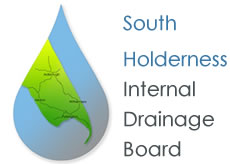The South Holderness Internal Drainage Board was formed on 31st March 2013 by an order under the Land Drainage Act 1991 which amalgamated the 6 boards (Keyingham, Preston, Ottringham, Skeffling, Winestead, Thorngumbald) which in most cases had been set up after the enclosure awards in the late 18th Century.
Whilst the boards had been well run by hands on members for centuries, through Government pressures and changing times, there was a need for a change to keep in line with current legislation.
The present board consists of 12 elected members together with one East Riding of Yorkshire Council Representative. Please see Members Page
The board has no full time employees. All maintenance works are contracted out.
The current Clerk is Mr Ralph Ward of Frank Hill & Son who is responsible for all clerical and financial matters and all enquiries should be addressed to him – please see contact page.
The majority of the board’s drains flow directly into Environment Agency maintained main rivers with pumped or Tidal outfalls.
The board are responsible for the maintenance of Preston New Clough, Ottringham Clough and Welwick Drain Outfall as well as parts of the Keyingham, Burstwick, Thorngumbald, Ottringham, Winestead, Skeffling Drains, Old Fleet, Preston New Drain and Reedmere Sewer. See Map page.
Role of an IDB
Water level management
IDBs believe in the principles of sound water level management through the close management of water levels – in watercourses and the surrounding landscape – for the purpose of reducing the risk from flooding and for sustaining all land uses and the environment.
Areas of special flood risk
Low-lying areas of England and Wales require the daily close attention of specialist local water level management bodies to actively manage and reduce the risk of flooding, and to ensure that the current land use, inhabitation and ecology is enabled to continue into the future.
These are areas that the Medway Letter sought to set boundaries for in 1933; in the 21st Century we should be building upon this solid foundation:
Catchment basis
Water level and flood risk management on a catchment basis should determine any strategic approach to flood risk management. This is a principle supported by the Water Framework Directive and Defra’s Future Water (2008) strategy and upheld by Internal Drainage Boards in England and Wales, Waterschappen in the Netherlands, Consorzi di bonifica in Italy and by other water level management authorities in many other countries across Europe.
IDBs will:
- Carefully manage water levels within their drainage districts for land drainage
- flood risk management
- irrigation
- environmental benefit - Work within hydrologically defined catchments
- Operate for the benefit of all ratepayers in their districts
- Be recognised as the land drainage authority within their districts
Purpose
IDBs cover 1.2 million hectares of England (9.7% of England’s total land area) and 28,500 hectares of Wales (1.4% of Wales’ total land area), 90% of the indicative flood map zone 3 for England and Wales. 24 of the county councils in England include one or more IDB in their area as do six metropolitan districts, and 109 unitary authorities or district councils.
IDBs are geographically concentrated in the Fens of East Anglia and Lincolnshire, Somerset Levels, Kent marshes, Trent valley and Yorkshire covering growth areas such as the Thames Gateway and Milton Keynes, and existing developed areas around Avonmouth, East Midlands and the Humber Estuary.
IDBs will:
- Through the functions listed above, defend and sustain land use, including inhabitation, agriculture, industry, recreation and natural habitats
- Facilitate and supervise the irrigation and drainage of agricultural land that helps feeds the nation
- Contribute to the security of civil infrastructure within their districts
- Aid the sustainability of rural and urban communities
